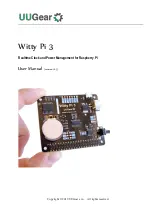
2 INSTALLATION MECHANICAL HF SSB TRANSMITTER
T2130
RETUNE PROCEDURE
This is the tune procedure normally used. The conditions for a retune procedure are the following:
-
A frequency within the same 200 kHz band has been tuned previously to an SWR
<= 2.0. This means that valid data are read out of the EEPROM’s and the aerial conditions have not
changed essentially.
The data saved in the EEPROM’s for a retune are divided into 142 elements. Each element equals a
frequency band covering 200 kHz. For each 200 kHz band a relay combination and a code for the tuned
SWR are saved.
The principles for a retune procedure are described in the following.
Data concerning the actual 200 kHz are read out of the EEPROM’s and validated.
If the code for the SWR is not acceptable an uptune procedure is started immediately.
If the code for the SWR is valid then the codes for the SWR and the relays are converted. The specific
relays are activated.
With the tune speed low the SWR is measured and compared continuously to the limit which is read out
from the EEPROM’s.
The SWR limit is 1.5 or 1.7 or 2.0. The retune procedure will then always try to tune to the same SWR
limit as the untune procedure. If however, this is not possible the retune will try to tune to the next higher
limit. If it is not possible to tune to an SWR <= 2.0 the uptune procedure is started immediately.
NO TUNE PROCEDURE
This procedure is run only when there is no AT2110 connected to the T2130. In fact the jumper 5 on the
TX-processor (3) must be inserted.
The only purpose for this routine is to measure the SWR and if the SWR <= 2.0 inform the RE2100 and
the user.
2.3.3.4
TRANSMIT SUPERVISING
The motives for the supervising are as follows:
-
Protection of the Transmitter T2130 against high SWR (bad aerial conditions).
-
Protection of the power transistors in Power Amplifier (1) against damage caused by high temperature.
-
Ensuring that the transmitter T2130 does always deliver maximum RF-power with a minimum of
intermodulation regardless of variations in the battery voltage supplying the Power Amplifier (1).
When the Transmitter T2130 is keyed, certain parameters are watched by the TX-processor (3) and action
is taken if the change of the parameters is essential. The following parameters are watched:
-
SWR, Standing Wave Ratio
-
Supply voltage to the Power Amplifier (1)
-
Temperature in the Power Amplifier (1).
In general a change of any of the watched parameters causes a control of the RF-level input to the Power
Amplifier.
While the transmitter is keyed the TX-processor has the full control of the digitally controlled step
attenuator in the Exciter Unit (4) in the RE2100 via the SP-Bus and the Processor Unit (5) in the RE2100.
9315
PAGE 2-32
Summary of Contents for COMPACT HF SSB T2130
Page 1: ...S P RADIO A S AALBORG DENMARK TECHNICAL MANUAL FOR SAILOR COMPACT HF SSB T2130...
Page 2: ......
Page 4: ......
Page 8: ......
Page 14: ......
Page 16: ......
Page 19: ...2 INSTALLATION MECHANICAL HF SSB TRANSMITTER T2130 9630 26197A PAGE 2 3...
Page 31: ...2 INSTALLATION MECHANICAL HF SSB TRANSMITTER T2130 PAGE 2 15...
Page 36: ...2 INSTALLATION MECHANICAL HF SSB TRANSMITTER T2130 2 2 13 CONNECTIONS TO N2161 26199 PAGE 2 20...
Page 88: ......
Page 90: ......
Page 92: ......
Page 96: ......
Page 100: ...5 CIRCUIT DESCRIPTION AND SCHEMATIC DIAGRAMS T2130 PAGE 5 4...
Page 104: ...PAGE 5 9 5 CIRCUIT DESCRIPTION AND SCHEMATIC DIAGRAMS T2130...
Page 120: ...PAGE 5 24 5 CIRCUIT DESCRIPTION AND SCHEMATIC DIAGRAMS T2130...
Page 126: ...PAGE 5 30 5 CIRCUIT DESCRIPTION AND SCHEMATIC DIAGRAMS T2130...
Page 128: ...T2130 5 CIRCUIT DESCRIPTION AND SCHEMATIC DIAGRAMS T2130...
Page 129: ...T2130 CONTENTS 6 PARTS LIST 9724...
Page 130: ......
















































